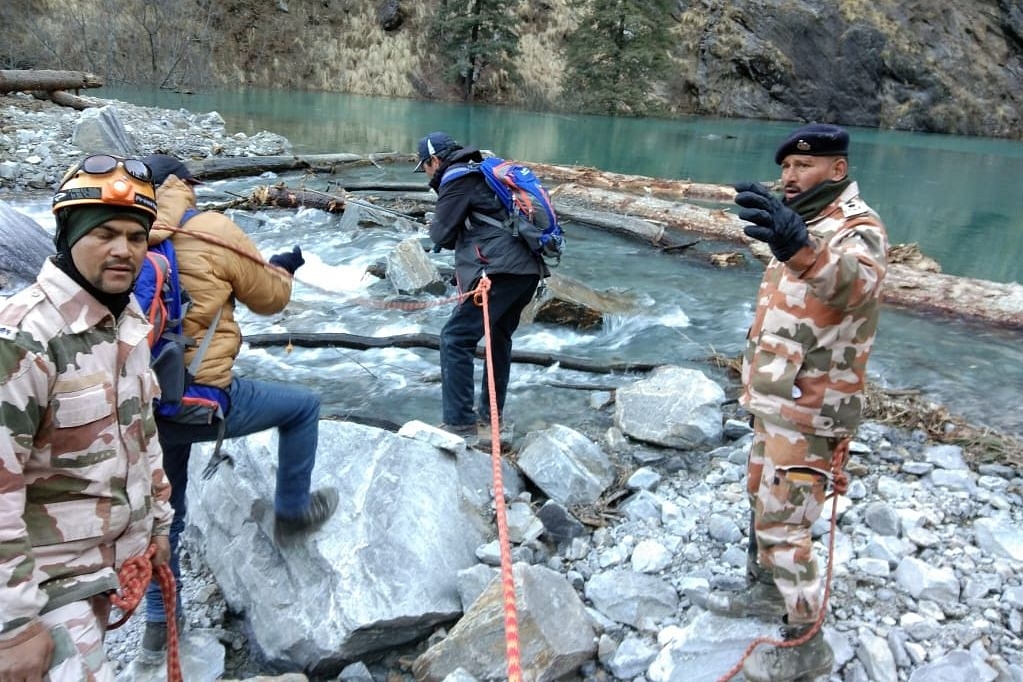Ideas
Uttarakhand: How ITBP Played A Vital Role In The Daring Task Of Widening The Mouth Of Lake Formed By Flash Floods In Chamoli
- The team has widened the mouth of the lake in order to prevent a repeat of a disaster.
- This would not have been possible without the footwork, the eyes, expertise and the courage of the ITBP personnel.

An ITBP team.
Weeks after flash floods hit Uttarakhand's Chamoli district, a team of experts including scientists, Indian military personnel, Indo Tibetan Border Police (ITBP) and disaster management personnel have taken a daring step to prevent a possibility of a tragedy.
The team has widened the mouth of the lake formed by the flash floods by 15 feet in order to prevent a repeat of a disaster in the difficult terrain.
The ITBP has played a vital role in the task that could not have been possible without the work at the lake site as well as the tackling of obstacles on the route to the lake site. A post on the official handle of the ITBP said: "We always respect the mountains while performing any task in the #Himalayas."
Members of the team had analysed the lake, including its depth, before going ahead with the risky and daring step of widening its mouth in the difficult terrain. The team members can be seen beginning their work with calls of reverence to Badri Vishal and Nanda Devi.
The team has widened the mouth of the lake, increasing the discharge from the lake to prevent a lake burst situation or a tragedy similar to the one that unfolded in the region earlier this month. This would have not been possible without the footwork, the eyes, expertise and the courage of the ITBP personnel.
Experts have been analysing the presence and details of the lake which was created after the flash flood and the resulting sludge blocked the flow of Rishiganga. There was fear that the lake could burst. The widening of the mouth from, reportedly, 20 feet to 35 feet, was done using special equipment.
State Disaster Response Force (SDRF) commandant Navneet Bhullar has been quoted as saying: “The special equipment, quick deployable antenna (QDA) based on satellite communication, has been set up there and it is helping us to have real-time communication with the expert team."
The expert team formed by the state authorities includes scientists from Uttarakhand Space Application Centre, Geological Survey of India, the first responders in the Himalaya — ITBP, and the SDRF.
The team had received inputs about the lake formation in the upstream Rishiganga. Efforts were made to widen the mouth of the lake.
A member of the team, Manoj Joshi, was sent to widen the lake mouth. He could manage to do it by "around six feet". Joshi is an Everest summiteer. He has been quoted as saying: “It was a very dangerous incline and widening it (the lake mouth) was difficult. I could widen it by a few feet only."
Last week, a quick deployable antenna (QDA) was flown in with the help of choppers to the lake area. Navy divers were sent to the lake for measuring its depth. The depth, reportedly, was found to be 8-9 metres. The access to the lake area is tough and the route is full of obstacles. The ITBP has made temporary log bridges across fast flowing water bodies on the route.
Earlier the ITBP and DRDO officials had reached the confluence of Rishiganga. They viewed the Raunthi Gad from what is known as the Muranda axis in the region. The team would cross Raunthi Gad in order to inspect the lake side from its rear.
In Muranda, the team established the base camp and selected a location for a helipad that would play a vital role in the days and tasks to come.
They encouraged each other while moving "cross country" on mountain slopes to reach Muranda with the calls of "aao, aao himveeron aayo (keep moving, Himveers, keep moving)".
Introducing ElectionsHQ + 50 Ground Reports Project
The 2024 elections might seem easy to guess, but there are some important questions that shouldn't be missed.
Do freebies still sway voters? Do people prioritise infrastructure when voting? How will Punjab vote?
The answers to these questions provide great insights into where we, as a country, are headed in the years to come.
Swarajya is starting a project with an aim to do 50 solid ground stories and a smart commentary service on WhatsApp, a one-of-a-kind. We'd love your support during this election season.
Click below to contribute.
Latest